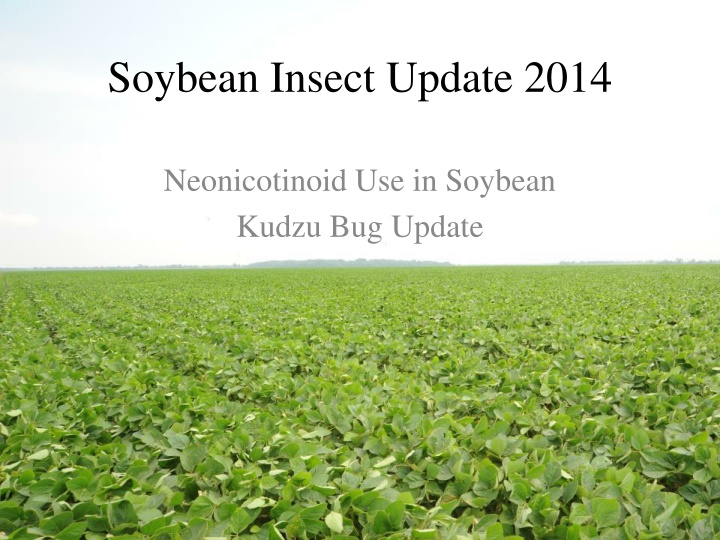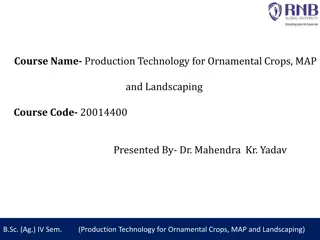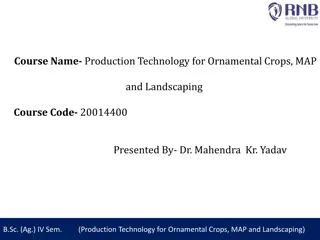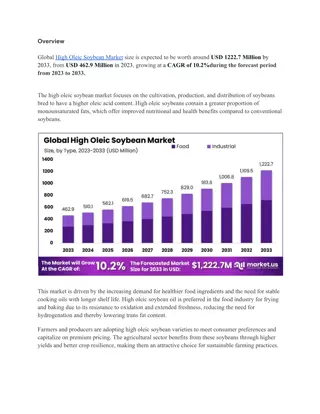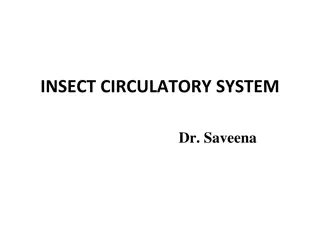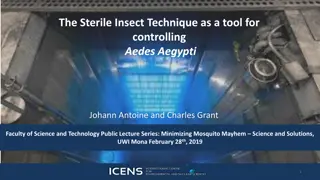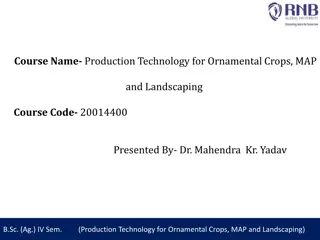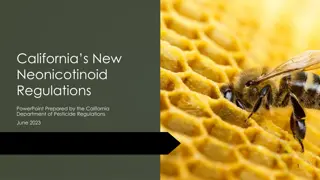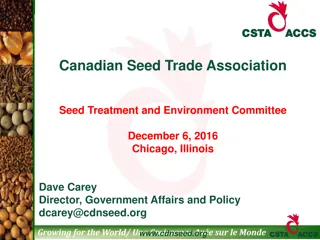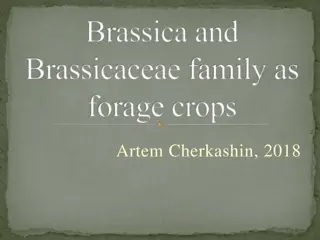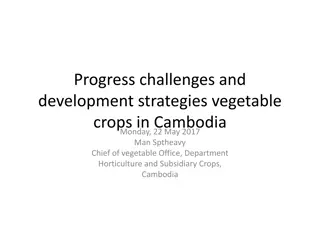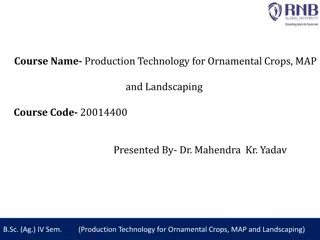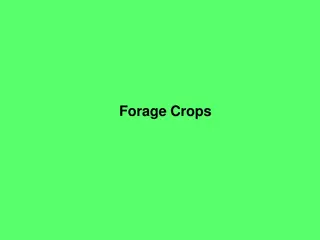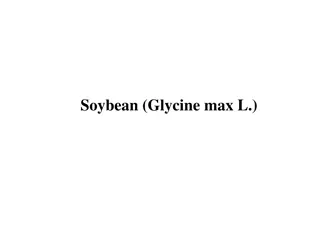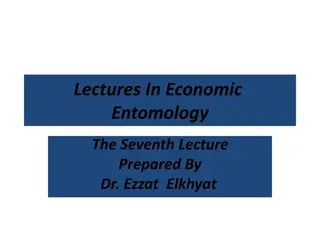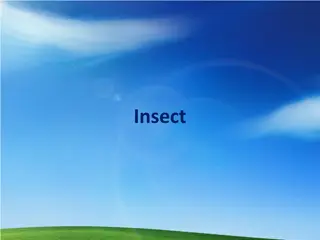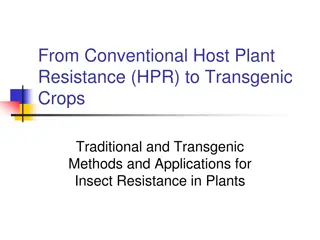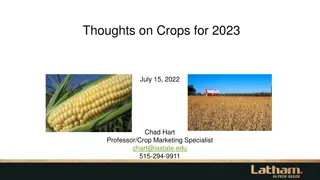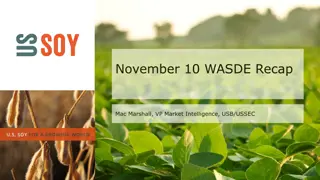Neonicotinoids in Field Crops: Update on Soybean Insect Control
Explore the use of neonicotinoids in soybean crops to control pests like aphids and beetles. Learn about their mode of action, concerns regarding environmental persistence, and effects on bee behavior. Discover the current status of neonicotinoid use in field crops and its implications.
Download Presentation

Please find below an Image/Link to download the presentation.
The content on the website is provided AS IS for your information and personal use only. It may not be sold, licensed, or shared on other websites without obtaining consent from the author.If you encounter any issues during the download, it is possible that the publisher has removed the file from their server.
You are allowed to download the files provided on this website for personal or commercial use, subject to the condition that they are used lawfully. All files are the property of their respective owners.
The content on the website is provided AS IS for your information and personal use only. It may not be sold, licensed, or shared on other websites without obtaining consent from the author.
E N D
Presentation Transcript
Soybean Insect Update 2014 Neonicotinoid Use in Soybean Kudzu Bug Update
Neonicotinoids and Spinosyns Nerve toxins Nicotinic acetylcholine receptor agonists (synaptic) Mode of action (4A) similar to nicotine (4B)
Neonicotinoids Not widely effective (but are selective) Good for Aphids Beetles Moths/butterflies Safer for humans Cause insect paralysis and death within hours
Neonicotinoids clothianidin dinotefuran imidacloprid thiamethoxam acetamiprid others Poncho, NipsIt, Belay Safari Gaucho, Admire Pro Cruiser, Avicta, Centric Assail
Where do we use neonicotinoids in field crops? Seed treatments Cotton (100%) Corn (100%) Soybean (>30%) Wheat (?) Foliar sprays Straight (Admire Pro, Belay, Centric, etc.) Pre-mix (Brigadier, Endigo, Justice, Leverage 360, Swagger, Triple Crown, etc.)
Source: USGS National Water Quality Assessment Program
Neonicotinoid Concerns Persistent in environment Possibly for months Not very toxic for aquatic organisms, birds, etc. BUT
Questions What concentrations of neonicotinoid change bee behavior? Minimal effects up to 20 ng/g Highest detected in corn pollen is 7 ng/g, most much lower What is the likelihood that bees will be exposed to neonicotinoids under average realistic conditions Not likely in Midsouth field crops (Stewart et al. 2014) Do Midwestern results apply across the US? Likely not
Directions For Use For Food Crops & Commercially Grown Ornamentals Not Under Contract for Pollination Services but are Attractive to Pollinators Do not apply this product while bees are foraging. Do not apply this product until flowering is complete and all petals have fallen unless one of the following conditions has been met. The application is made to the target site after sunset The application is made to the target site when temperatures are below 55 F The application is made in accordance with a government-initiated public health response
Directions For Use For Food Crops & Commercially Grown Ornamentals Not Under Contract for Pollination Services but are Attractive to Pollinators The application is made in accordance with an active state-administered apiary registry program where beekeepers are notified no less than 48- hours prior to the time of the planned application so that the bees can be removed, covered or otherwise protected prior to spraying The application is made due to an imminent threat of significant crop loss and a documented determination consistent with an IPM plan or predetermined economic threshold is met. Every effort should be made to notify beekeepers no less than 48 hours prior to the time of the planned application so that the bees can be removed, covered, or otherwise protected prior to spraying.
Farmer/Beekeeper Communications Mississippi s Bee Aware Flag Part of a larger statewide effort in MS to foster communication Hive and Flag Placement GPS Notify Ground and Aerial Applicators of Hive Locations Timing of Applications
Pollinator Stewardship Task Force NC Pollinator Stewardship Task Force - NC Farm Bureau - NCDA&CS - Commercial Beekeepers Potential work: Pollinator Protection Plan Flags Mapping - NCSU - Commodity Groups
Commercially Available Insecticidal Seed Treatments Trade Name Active Ingredients Cotton rates per seed Thrips Insecticide* Additional Name Recommended rate per seed Acceleron imidacloprid 0.07-0.23 mg fluxapyroxad, mefenoxam, metalaxyl 0.375 mg Cruiser 5FSa thiamethoxam 0.08-0.15 mg 0.375 mg CruiserMaxxa CruiserMaxx Advanceda thiamethoxam 0.16-0.48 mg mefonoxam, fludioxinil 0.375 mg thiamethoxam 0.08 mg mefonoxam, fludioxinil 0.375 mg Inovate IST-Gauchob clothianidin 0.075 mg metalaxyl, ipconazole imidacloprid 0.07-0.23 mg 0.375 mg Poncho/VOTiVO clothianidin 0.13 mg (clothianidin) Bacillus firmus I-1582 0.424 mg aClariva Complete Beans seed treatment with CruiserMaxx Beans (insecticide/fungicide) + Clariva pn (nematicide) + Vibrance (fungicide). CruiserMaxx Beans is seed treatment with one of the following: 1) CruiserMaxx alone, 2) CruiserMaxx Advanced + Apron XL (fungicide), 3) Cruiser 5 FS insecticide + Maxim 4FS + Apron XL (fungicides), or 4) Cruiser 5FS + ApronMaxx (fungicide) bTrilex 6000 seed treatment with Gaucho (insecticide) + Trilex + Yield Shield + Allegiance + Celgard (fungicides)
Insecticide Seed Treatment Adoption in Beans Year 2004 2005 2006 2007 2008 2009 2010 2011 2012 2013 2014 Mississippi 0% 0% 0% 2% 50% 65% 70% 75% 85% 90% ? North Carolina - - - - - - - 12% 15% 29% 30%
Soybean Seed Treatments As of 2014 in Virginia and North Carolina 18 seed treatment tests 5 foliar treatment tests NO YIELD ADVANTAGE It is not worth using an insecticidal seed treatment
Paratelenomus saccharalis Attacks only Plataspidae (Megacopta cribraria, M. punctatissimum, Brachyplatys subaeneus), no other known hosts
Seiter, N. J., A. Grabke, J. K. Greene, J. L. Kerrigan, and F.P.F. Reay-Jones. 2014. Beauveria bassiana is a pathogen of Megacopta cribraria (Hemiptera: Plataspidae) in South Carolina. Journal of Entomological Science. 49: 326-330.
Thresholds Seedling/vegetative soybeans 5 bugs per plant (adults or nymphs) Stop using threshold for second generation bugs (generally in July) Vegetative to reproductive (R7) soybeans One nymph per sweep ( swoosh of the net) Preliminary Established
Kudzu Bug Insecticide Efficacy Summary (2010-2012) Triple Crown Brigadier Brigade, Discipline, Sniper, Fanfare, SkyRaider Hero Karate Z, Warrior Sevin, Carbaryl Endigo Stallion Mustang Max Cobalt Advanced Declare Orthene 97 , Acephate 97 Nufos, Chlorpyrifos Asana XL Baythroid XL, Tombstone Helios Leverage 360 Belay Preserves some beneficials Belt 2-5 DAT Dimilin 6-14 DAT Intrepid Steward 0 20 40 60 80 100 P. Roberts, J. All (University of Georgia) J. Greene, N. Sieter (Clemson University) D. Reisig, J. Bacheler (North Carolina State University) Percent Control (2-5 DAT and 6-14 DAT)
Log-dose probit mortality of 3rd stage instars, North Carolina 2013 95%FLa 52.17-107.17 1.40-2.70 313.32-561.96 X2b 9.64 9.49 9.26 Insecticides Imidacloprid Bifenthrin Acephate N 180 180 180 LC50 (ppm) 15.56 0.48 115.17 95%FL 12.70-18.79 0.37-0.57 97.35-135.82 LC90(ppm) 70.7 1.83 400.71 Slope 1.96 2.16 2.37 SE 0.21 0.25 0.23 LD-P line Y=1.96x+2.66 Y=2.16x+5.68 Y=2.37x+0.12 df 9 9 9 P 0.47 0.39 0.27 a N, number of Kudzu bugs tested; FL, fiducial limits. b Chi-square testing linearity of dose mortality response.
Tillage: Early colonization Tilled plots No-till plots, planted after rye or wheat
P-value=0.0461 Total kudzu bug adults / 40 sweeps Equation: Y = 9.9636 0.0454 X R2 = 0.2919 Percent ground cover
